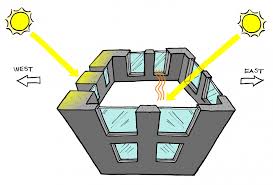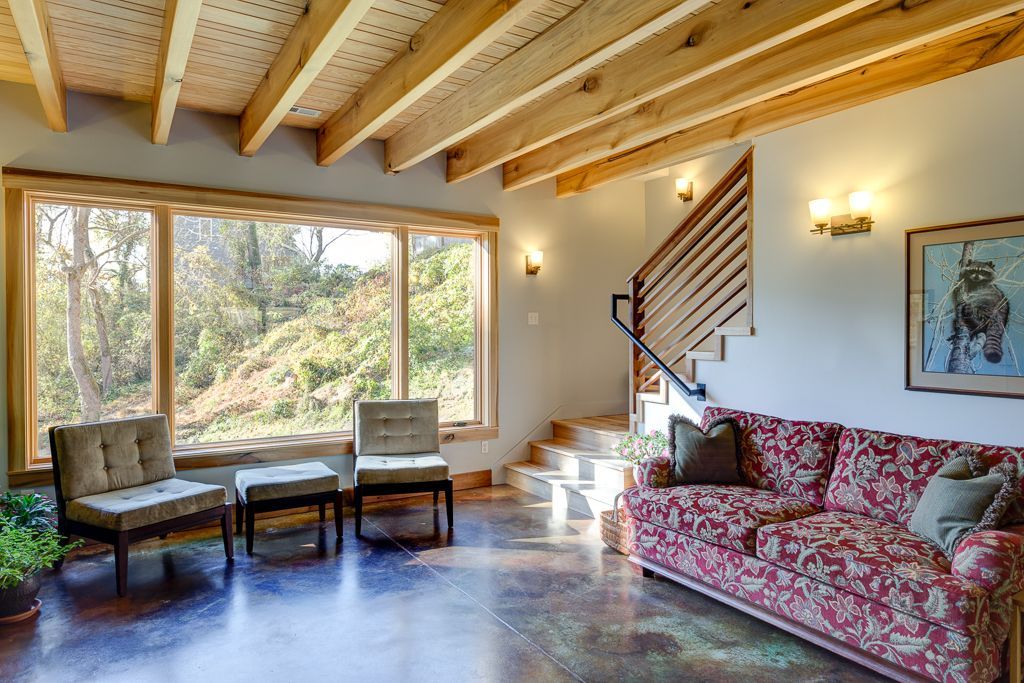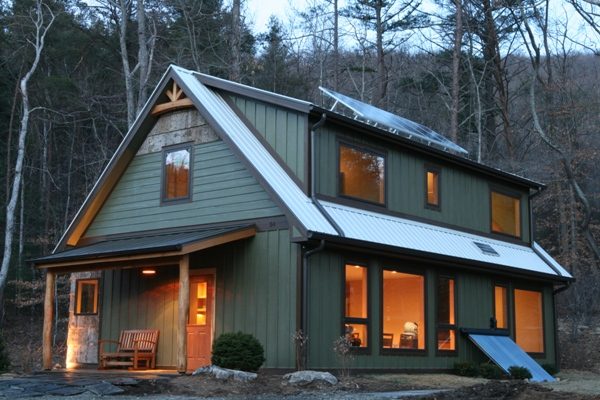
Knowing the impacts of window quantity and their orientation with the path of the sun will help the process of choosing overhangs, covered porches, U-factor (R-value) and especially Solar Heat Gain Coefficient SHGC. This information involves site and design. It applies to new construction, renovations, window replacement and landscaping.
Choosing windows Part 1, summarizes choosing by brand and supplier. It lists typical window styles with thoughts on their energy efficiency and ergonomics. Part 2 is a bigger picture of choosing windows. These more hidden influences will have the greatest impact on upfront costs, comfort, energy use and durability. Windows are used for views, light and connections with the outdoors. Every building site is different and good design takes advantage of opportunities, while being mindful of inappropriate relationships on both sides of the windows.

Some sites and design goals lead to large amounts of glass. Many are drawn to the natural light and connection with the outdoors. Not all sites afford the lack of privacy and for those on limited budgets, windows are expensive upfront with higher maintenance and monthly energy costs compared to solid wall area.
Windows in general, increase building costs, energy use, maintenance and are bad for the environment. Windows are weak links in our building envelope but strong to our hearts and desires. Good design provides balance and is capable of boosting performance.
Adjusting dials of window costs and performance starts with Total Window Area and Directional Orientation.
Total Window to Floor Area.
Resfen, a window energy modeling software used by energy raters, assigns a 15% default of window to floor area for an average 2000 sqft home. Many homes have more glass, some less but it’s a fair average for comparisons. By paying attention to the directional orientation of the windows, we make significant impacts on heating and cooling performance of homes and buildings.
Orientation
Designing with the path of the sun is an easy way to maximize a home’s window investment. Here is a breakdown on the cardinal directions and how they affect window’s influences on architecture.
North
This is the most desirable direction for even, day-long light. Its well known among artists for its accurate color rendering and lack of glare. Its a safe direction to have windows protected from overheating concerns. For best daylighting, overhangs should be minimal yet balanced with the rain protection benefits they provide. Covered porches over north facing windows will dramatically reduce natural light available to the inside.
North facing windows are the worst for heating performance. In the winter, they contribute almost nothing to solar heat gain. High performance windows are beginning to overcome these drawbacks and super performance triple pane windows are capable of contributing slightly more heat than they lose, even on the north sides of a home. For budgets wanting to stay balanced in heating performance, north-facing window quantities should be as modest as possible.
South

South is the most important direction for heating performance. By increasing south-facing window area and Solar Heat Gain Coefficients SHGC, we generate free heat, daylighting and passive survivability. Passive survivability, meaning the home rarely drops below 45-50F during extended winter power outages.
 Passive Solar Design provides heat for free.
Passive Solar Design provides heat for free.
% of south-facing, high SHGC glass to floor area
This is passive solar design’s most descriptive variable, but be aware that blower door test results are a more important measurement for the overall performance of a home. We aim at 8-10% for passive solar designs with building envelopes at international code minimum levels of performance. Designs with more than 10-15% have more risks of overheating. For high performance envelopes that are tight and extremely insulated like passive haus or net-zero optimized, its advised to stay 7% or under to avoid overheating.
East
The direction for bedrooms or kitchens for early risers or those that appreciate morning sun. East windows in average situations have a neutral effect on overall energy performance, contributing morning heat in the winter and unwanted heat in the summer depending on shading, porches or overhangs, quantity of windows and SHGC.
West
This is typically the least efficient orientation in our climate. No direction contributes to overheating and discomfort like the west. Unshaded west walls without windows have a measurable negative influence, heated by the setting, summer sun. With windows involved, it gets much worse. Low SHGC glass, deep overhangs like those from covered porches and landscaping help control this orientation of most concern. Its wise to reduce the quantity of west windows as much as possible in our mixed climate, especially if not well protected by covered porches or big, shade trees.
Not all sites and designs will allow the generalities discussed here which is why it can be wise to involve professional designers and energy modeling to help fine tune the variables in the planning and design stages. Views and street alignment dictate window placement. Good design and smart window choices help balance needing windows in undesirable directions.

In Choosing Windows Part 3: Materials, we discuss window unit materials exposed to the exterior.
Brian Knight is the owner of Springtime Builders custom home builders in Asheville NC.

